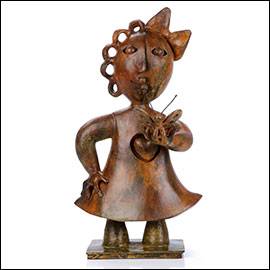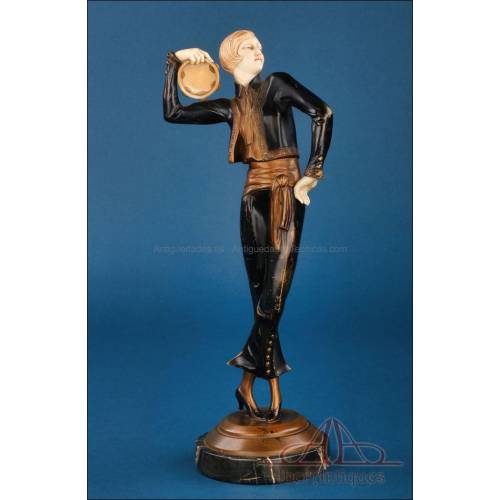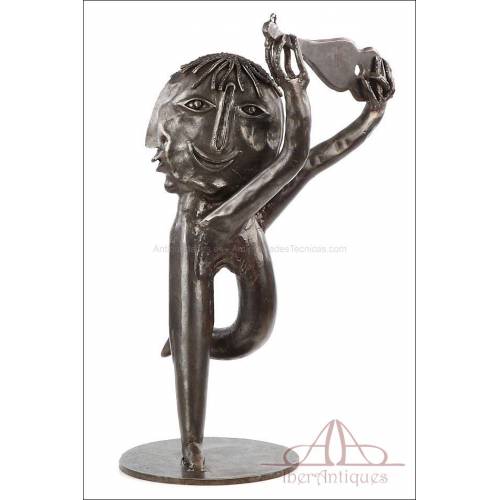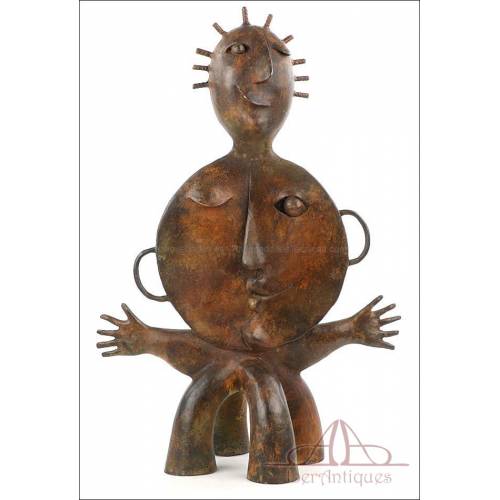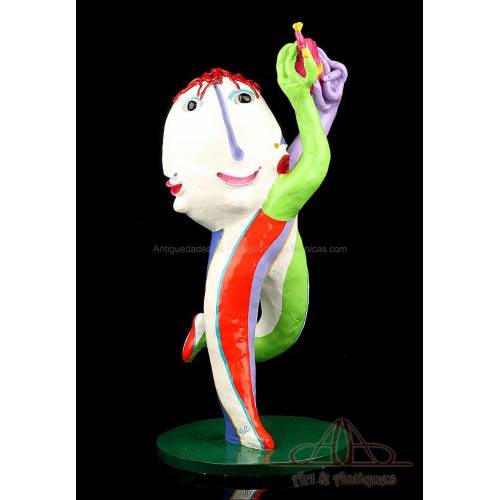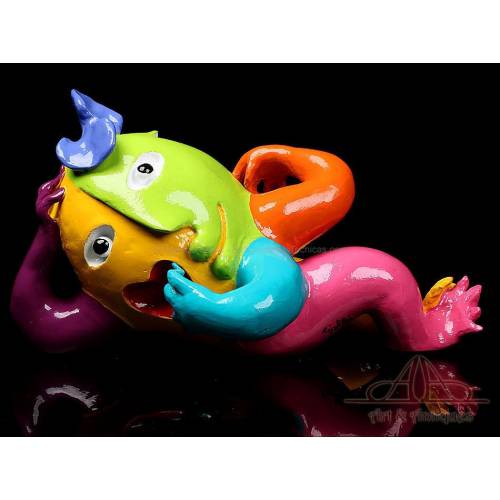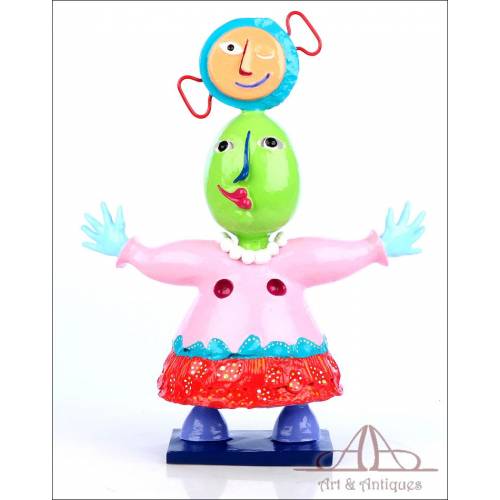Bronzes and calamines
Bronze and calamine sculptures: a bit of history
As we mentioned, the Bronze Age is so named because it was during those years when the metallurgy of this material was developed. Bronze is an alloy of copper and tin, copper being the base metal. Tin appears in the alloy in a proportion between 3 and 20%, depending on the mixture. It is a fundamental material in the history of mankind, as it was the first quality alloy created by man. Bronze was used to build weapons, practical utensils, jewelry or coins, but also for the creation of art objects.
In Antique Egypt, bronze statuettes were common; but it was the Greek civilization that first created large statues. The Romans, for their part, made this technique their own and perfected it. A good example is the horse head found in a German site, dating from the first century and gold plated, which has been valued at about 1.7 million euros and today can be admired in the Roman Fort of Saalburg (Germany).
On the other hand, the origin of calamine sculptures is much more recent. This alloy involves three elements: calamine (zinc carbonate), tin and lead. It was at the time of the French Revolution when it began to be used to make statues and figures, due to the shortage of copper (essential for making bronze and brass) caused by the uprisings. The calamine allowed to continue creating objects of art and for decoration; to improve their appearance, the figures were polychromed, gilded or patinated afterwards. The period of greatest splendor of antique calamine was between the late nineteenth and early twentieth centuries, coinciding with the rise of styles such as Art Nouveau or Art Deco.
Which is more interesting: buying antique bronzes or buying antique calaminas?
Of course, we do not have a categorical answer to this question. It all depends on the interest and taste of the buyer, the availability of quality pieces, the destination you want to give to the objects and your budget. In any case, both options allow to obtain works of art full of beauty, charm and history, perfect to decorate a room or dazzle in a showcase dedicated to the best of the collections.
And there is no reason to be limited only to bronzes and calamines. There are other alternatives for those interested in starting an art collection: without going any further, resin statues and other artistic products. This is the case of the famous 'Nanas' of the French artist Niki de Saint Phalle, which today reach exorbitant figures at auctions. Or, within the field of collecting, the delicious polychrome resin figures of the Valencian sculptor Juan Ripollés. Fantastic pieces full of beauty and expressiveness, perfect for illuminating spaces with the unique character of the most special works of art.
Girl with Tambourine, by Paul Philippe. Art Deco Chryselephantine. C. 1925. Girl with Tambourine, by Paul...
Original Art Deco sculpture by Paul Philippe, circa 1925. Chryselephantine in bronze and ivory with marble base. Timeless elegance and movement. Original Art Deco sculpture by Paul...
10 500,00 €Gorgeous Patinated Iron Sculpture by Joan Ripollés. Signed. Unique Piece Gorgeous Patinated Iron...
Awesome sculpture by Joan Ripolles, a unique piece with certificate of authenticity. Patinated cast iron. Awesome sculpture by Joan Ripolles, a...
3 600,00 €Gorgeous Patinated Bronze Sculpture by Joan Ripollés. Signed and Numbered. Gorgeous Patinated Bronze...
Amazing bronze sculpture by Joan Ripollés no. II/VIII. Big size. With certificate of authenticity. Amazing bronze sculpture by Joan...
4 700,00 €Girl with Guitar. Resin Figure by Joan Ripollés. Unique Piece Girl with Guitar. Resin Figure...
Sculpture Girl with Guitar signed by Joan Ripollés. Unique piece with a distinctive polychrome. Sculpture Girl with Guitar signed by...
3 200,00 €Child Lying Down. Resin Figure by Joan Ripollés. Unique Piece Child Lying Down. Resin Figure...
Polychrome resin figure made by Joan Ripollés. Unique Piece. Signed and in excellent condition. Polychrome resin figure made by Joan...
1 300,00 €Striking Sculpture by Joan Ripollés. Limited and Numbered 24/33 Striking Sculpture by Joan...
Striking sculpture by Joan Ripollés in polychrome resin. Original by the artists and signed at the foot. 16.54 high. Striking sculpture by Joan Ripollés...
2 200,00 €
New products
-

Antique ivory and silver plated stethoscope, late 19th century
Antique stethoscope from the late 19th century in silver-plated metal...
-

Vintage pendant with shell cameo of Jesús del Gran Poder, carved c. 1970
Vintage pendant with a shell-carved cameo of Jesus del Gran Poder, circa...
-

Antique Roman Style Gilded Silver Chalice with Paten. France, 1932
Antique Roman-style chalice in gilded silver with paten. France, 1932....
-

Beautiful Antique 18 K Gold Ring with 7 Natural Diamonds
Antique 18K gold ring with 7 natural diamonds. Delicate openwork design,...
-

Antique Silver Reliquary. José Vilaplana. Valencia, Spain. Circa 1920
Impressive repoussé silver reliquary by José Vilaplana, Valencia, c....
-

Vintage 18K Gold Ring with 7 Natural Diamonds
Vintage 18K gold ring with seven natural diamonds in floral setting....
-

Antique Silver Chalice. Enameled Crosses. Valencia, Spain, 1942
Spanish chalice from 1942 in solid silver, gifted by the Church of...
-

Antique Silver Chalice and Paten. Granada Spain, circa 1900
Spanish chalice in white silver with matching paten, handcrafted....
Specials
-

Antique Powder Case for Harquebusier. Spain 16th C. Circa 1580
Amazing 16th century harquebusier...

